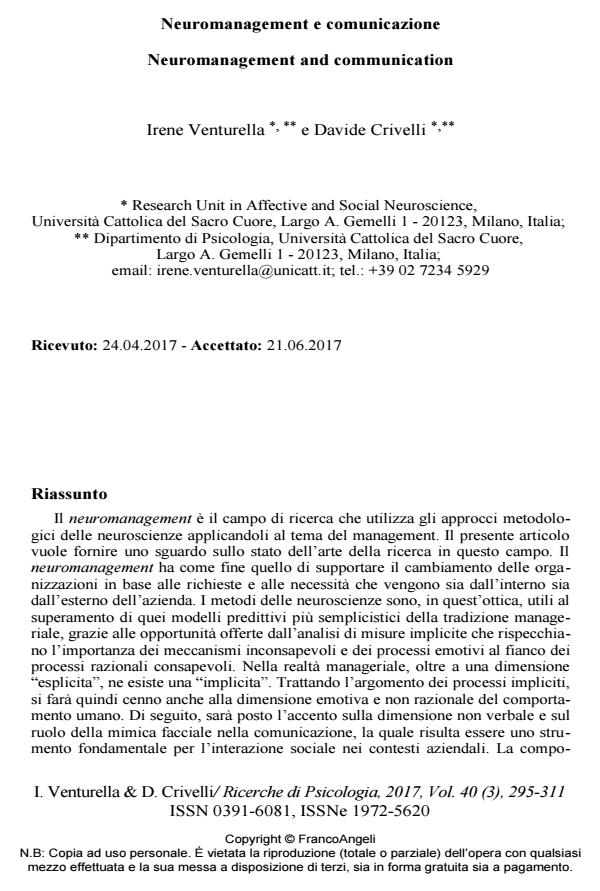Neuromanagement e comunicazione
Titolo Rivista RICERCHE DI PSICOLOGIA
Autori/Curatori Irene Venturella, Davide Crivelli
Anno di pubblicazione 2017 Fascicolo 2017/3
Lingua Italiano Numero pagine 17 P. 295-311 Dimensione file 231 KB
DOI 10.3280/RIP2017-003002
Il DOI è il codice a barre della proprietà intellettuale: per saperne di più
clicca qui
Qui sotto puoi vedere in anteprima la prima pagina di questo articolo.
Se questo articolo ti interessa, lo puoi acquistare (e scaricare in formato pdf) seguendo le facili indicazioni per acquistare il download credit. Acquista Download Credits per scaricare questo Articolo in formato PDF

FrancoAngeli è membro della Publishers International Linking Association, Inc (PILA)associazione indipendente e non profit per facilitare (attraverso i servizi tecnologici implementati da CrossRef.org) l’accesso degli studiosi ai contenuti digitali nelle pubblicazioni professionali e scientifiche
Il neuromanagement è il campo di ricerca che utilizza gli approcci metodologici delle neuroscienze applicandoli al tema del management. Il presente articolo vuole fornire uno sguardo sullo stato dell’arte della ricerca in questo campo. Il neuromanagement ha come fine quello di supportare il cambiamento delle organizzazioni in base alle richieste e alle necessità che vengono sia dall’interno sia dall’esterno dell’azienda. I metodi delle neuroscienze sono, in quest’ottica, utili al superamento di quei modelli predittivi più semplicistici della tradizione manageriale, grazie alle opportunità offerte dall’analisi di misure implicite che rispecchiano l’importanza dei meccanismi inconsapevoli e dei processi emotivi al fianco dei processi razionali consapevoli. Nella realtà manageriale, oltre a una dimensione "esplicita", ne esiste una "implicita". Trattando l’argomento dei processi impliciti, si farà quindi cenno anche alla dimensione emotiva e non razionale del comportamento umano. Di seguito, sarà posto l’accento sulla dimensione non verbale e sul ruolo della mimica facciale nella comunicazione, la quale risulta essere uno strumento fondamentale per l’interazione sociale nei contesti aziendali. La componente verbale nell’interazione face-to-face, infine, integra la dimensione non-verbale con quella propria del processo comunicativo dello scambio di battute, arricchendo e completando il processo comunicativo per la creazione di significato.
Parole chiave:Neuromanagement, comunicazione, strumenti neuroscientifici, processi impliciti, mimica facciale, face-to-face.
- Face-to-face vs. remote digital settings in job assessment interviews: A multilevel hyperscanning protocol for the investigation of interpersonal attunement Michela Balconi, Giulia Fronda, Federico Cassioli, Davide Crivelli, Humaira Nisar, in PLOS ONE /2022 pp.e0263668
DOI: 10.1371/journal.pone.0263668
Irene Venturella, Davide Crivelli, Neuromanagement e comunicazione in "RICERCHE DI PSICOLOGIA " 3/2017, pp 295-311, DOI: 10.3280/RIP2017-003002